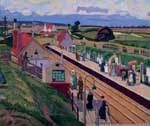Tips on investing in Art
The market is still booming and there's never been a better time to buy as Clive Aslet discovers in talking to three collectors


Beyond the iron bedsteads and iron street railings, the tired tarts and tired cab horses, the gaudy music halls and gaudy peeling wallpaper of charmless bedsits that characterise so many paintings of the Camden Town Group lies a surprise. The latest exhibition at Tate Britain includes a series of works its curators classify as 'anti-Modern'. Landscape paintings, they depict, in thick impasto, views of Devon, Dorset and Dieppe, Sussex and Sweden, the Romney Marshes and Richmond Park. All apply Modernist technique to traditional subjects and demonstrate the extent to which consciously Modern British artists, wrestling a century ago with the implications of Post-Impressionism, Cubism and Futurism, succumbed, never the less, to the pastoral yearnings of their forebears.
Robert Bevan painted several views of a coachman's cottage in Devon, close to the border with Somerset. The coachman was Frank Dunn, his employer Harold Bertram Harrison. In 1909, Harrison, an amateur artist and ex-Slade pupil, inherited Applehayes, an estate in the Blackdown Hills, and set about building a studio wing with bachelor accommodation attached for visiting artists. The work that Spencer Gore, Harold Gilman, Charles Ginner and Robert Bevan produced at Applehayes clothes apparently nostalgic subject matter in a bright, bold, new mantle, in which flat, geometric planes of colour, simplified outlines and richly applied paint coalesce to create images of enduring loveliness of a sort unexpected by the Camden Town Group's detractors. Bevan's Dunn's Cottage of 1915, like fellow group member Lucien Pissarro's High View, Fishpond, painted in Dorset in the same year, offers the viewer a fresh icon of Englishness. All the lessons of Continental Modernism infuse this image of stillness and homespun lyricism.
The effect is of simplicity and charm, and the countryman in every Englishman thrills to its gentle poetry. The Camden Town Group was an association of 16 artists. All men, they exhibited together on only three occasions in June and December 1911, and in December 1912 in the basement of the Carfax Gallery in Bury Street, St James's. They also sold direct to the public through Saturday at home' sessions, held in a studio at 19, Fitzroy Street, rented by Walter Sickert. Sickert was the driving force behind the group. He had lived and worked at a number of addresses in Camden Town, at the time a less than glamorous district of the capital.
The area's insalubrious nature was part of its attraction, both for Sickert and for the group as a whole. Between 1907 and 1909, Sickert painted a number of unlovely, fleshy nudes, more than one of which he entitled The Camden Town Murder, thereby successfully capitalising on the highly publicised murder, on September 11, 1907, of former prostitute Emily Dimmock in her Camden Town bedsit. Other group members lived close by. William Ratcliffe's Clarence Gardens and Spencer Gore's The Fig Tree and Mornington Crescent portray, with unblinking directness, the dusty contours of this unassuming locality.
Economic pressure bound together many of the 16 artists. Beyond that motivating factor, their work demonstrates limited homogeneity. Most made a deep engagement with the assertively urban subject matter close at hand, both within and beyond the walls of their Camden Town living and working quarters. It's these scenes local streets, cab yards, shadowy interiors, flaccid looking nudes and gaslit heatres beside portraits of one another and their cast of enervated domestic help, which have come to define the group's outlook and work. There were always some exceptions. Augustus John and Henry Lamb made no connection with the group s London focus, and Sickert resisted the radiant Colourist experiments of Gore, Bevan, Gilman and Ginner.
The curators of the current exhibition have responded to this conundrum by focusing on only nine of the original 16 artists. The result is a show that, although rich in contrasts, suggests a vibrant, handsome and coherent British response to Post-Impressionism, and a disarmingly new way of representing, in two dimensions, the physical business and psychological tensions of the world around us proof of Sickert's definition of the artist as 'he who can take a piece of flint and wring out of it drops of attar of roses'. 'Modern painters: The Camden Town Group' is at Tate Britain, London SW1, until May 4 (020 7887 8888; www.tate.org.uk)
Exquisite houses, the beauty of Nature, and how to get the most from your life, straight to your inbox.
Country Life is unlike any other magazine: the only glossy weekly on the newsstand and the only magazine that has been guest-edited by His Majesty The King not once, but twice. It is a celebration of modern rural life and all its diverse joys and pleasures — that was first published in Queen Victoria's Diamond Jubilee year. Our eclectic mixture of witty and informative content — from the most up-to-date property news and commentary and a coveted glimpse inside some of the UK's best houses and gardens, to gardening, the arts and interior design, written by experts in their field — still cannot be found in print or online, anywhere else.
